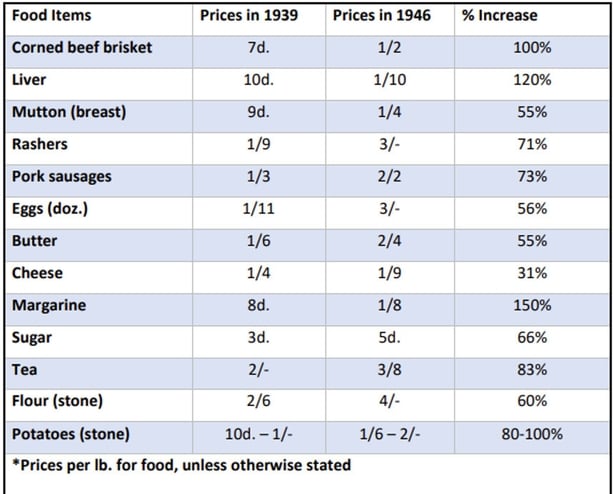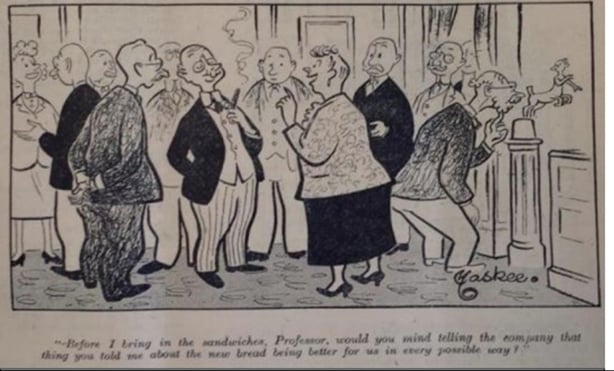Analysis: 'black bread' was the physical embodiment of the State's efforts to feed its population in the face of severe wheat shortages during the Emergency
Common knowledge suggests that brown bread, or wholemeal bread is the healthiest form of bread for human consumption. The more whole grain, the better, right? Not exactly, as the case of 'black bread' in Ireland during the Second World War shows.
The term 'black bread' was banned by the Irish censors in January 1941, afraid that use of the term would draw attention to the problems created by the Emergency regime. Black bread was the physical embodiment of the State’s efforts to feed its population in the face of severe wheat shortages.
Alongside the 'Grow more wheat' campaign (which aimed to maximise wheat production) were adjustments to flour extraction. Increasing extraction during flour milling process was used by the Government to minimise wheat wastage during the Emergency.
We need your consent to load this rte-player contentWe use rte-player to manage extra content that can set cookies on your device and collect data about your activity. Please review their details and accept them to load the content.Manage Preferences
From RTÉ Radio 1's History Show, Bryce Evans on life in Ireland during the Second World War
Normal practice before the war was to produce wheaten bread from flour that was extracted at the 70 to 75% mark. As flour was among the more severe wartime shortages, one resolution to poor wheat supplies was to increase extraction rates. The rate that flour was extracted from wheat was continuously increased, measuring at 100% on some occasions during the war.
High extraction flours produced a loaf of a dark, grey-brown colour and the use of the term ‘black bread’ was common in Irish vernacular. While flour becomes more nutritious at higher levels of extraction, there is an upper limit to this. Crucially, close to 100% extraction meant that the Government was encouraging millers to create a product that contained matter that the human body simply could not digest.
Medical research showed the detrimental side effects of high extraction rates on public health. As early as 1940, studies in Britain confirmed suspicions that higher levels of the toxins phytic acid were in flour extracted at higher rates. Phytic acid immobilised human absorptions of calcium, thereby limiting a nutritional intake vital for human growth. Despite this, extraction rates in Ireland were not lowered until December 1943 and flour was not fortified with calcium until June 1946.
Medical research showed the detrimental side effects of high extraction rates on public health
The prevalence of rickets in Ireland increased substantially during wartime. A deficiency disease that occurs in growing infants and children, rickets is associated with a vitamin D deficiency and a lack of calcium. As the disease develops, skeletal abnormalities can occur, leading to disturbances in bone growth.
An investigation found that the incidence of rickets in Dublin had risen from 10 cases per 1,000 children under 4 years of age in 1939 to a disturbing high of 230 cases per 1,000 children by 1943. Cases were mostly children of the poor, though some families benefitted from the remittances of a father who had gone to work in England.
To protect children against rickets, calcium and vitamin D intake had to be optimal, making due allowance for substances which might lesson absorption. Main vitamin D sources in the diet were milk, butter and eggs. It was accepted that a child should ingest at least 0.75gm of calcium daily which could be obtained from a little over a pint of milk.

Despite the fact that 100% extraction flour contained more calcium than white flour, higher quantities of phytic acid prevented its assimilation into the human digestive system. This was particularly detrimental when it was placed within a context of severe food shortages.
In Dublin, 40,000 gallons of milk were consumed daily – the equivalent of about half a pint per head of the population. The additional fact that eggs were a luxury which few poor families could afford meant that the quick-fix methods of wartime rationing became visually apparent in the bodies of lower-class children.
Tuberculosis was another serious problem during wartime. TB is a chronic bacterial disease caused by the growth of bacillus mycobacterium tuberculosis in bodily tissues. Doctors like William J.E Jessop, Conn Ward and Theo Wolfe Tone Dillon raised the questions of whether a lack of calcium weakened one's resistance to a TB infection or if advanced cases of disease might benefit from the administration of calcium.

Public health arguments favouring fortification argued that any measure that was likely to encourage resistance to TB and reduce the occurrence of rickets was desirable. In 1943, 1,014 people died from pulmonary TB at the time of 100% extraction – the highest increase from 1939 (the lowest on record).
It was only after questions were raised as to the relationship between calcium intake and the rising incidence of rickets and tuberculosis that changes were made. These changes occurred in the context of debates over economic survival and health, and were too little too late. Ironically, the fortification of bread with calcium increased its cost, thereby moving it further away from poorer population groups.
Today, the risk of a worldwide wheat shortage has been high due to the Covid-19 pandemic, high energy costs, climate change and the ongoing war in Ukraine. This would have knock-on effects in price increases, pressure on wheat-producers and an overall negative impact on the global economy, but it would still affect the poor worst of all.
The views expressed here are those of the author and do not represent or reflect the views of RTÉ



